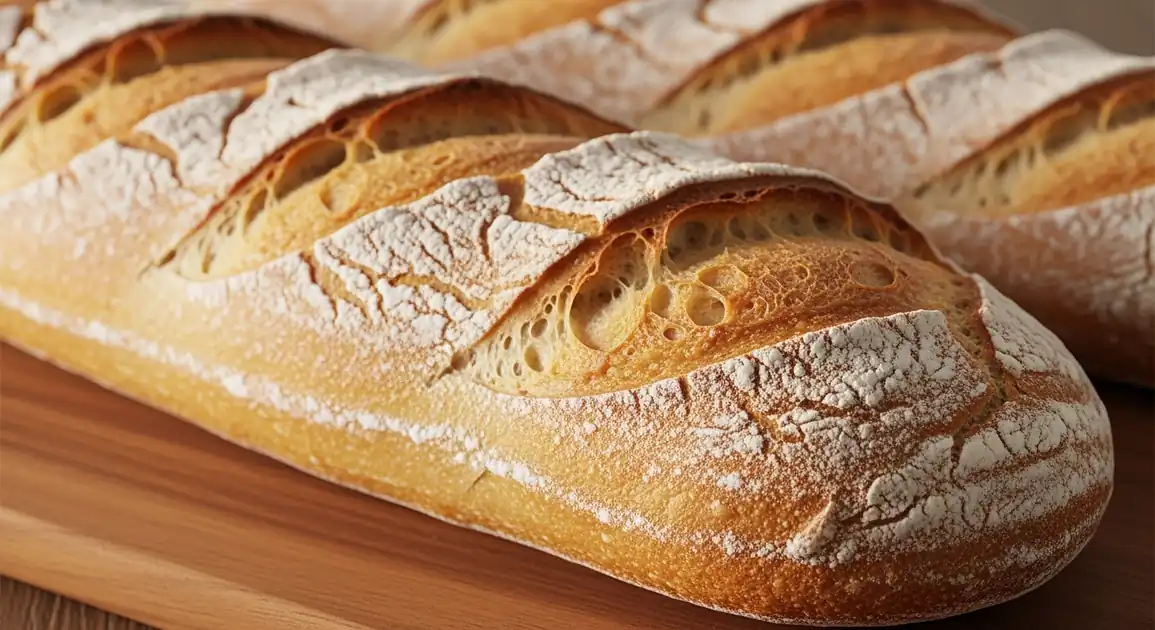Baguette Tradition
Baguette de Tradition Française

Description
The Baguette Tradition is fundamental to French food culture nationwide, protected by the 1993 'Décret Pain' that established its quality standards. While available throughout France, the finest examples are found in artisanal bakeries committed to traditional methods, where it represents the pinnacle of everyday bread consumption.
Dietary Information
Serving information
Serving style
Traditionally served whole or torn (not sliced) for casual eating. Commonly enjoyed with butter, cheese, charcuterie, or simply plain. Presented in paper bags or wrapped in paper.
Quick facts
Most bakeries open from 7 AM - 8 PM (closed Sundays or Mondays). Baking schedules typically include early morning (6 AM), mid-morning (10 AM), and late afternoon (4 PM) batches.
Safety Tips
What to Look For
-
Bread baked on premises (look for 'Artisan Boulanger' sign)
Ensures authenticity and freshness. True artisan bakeries make dough and bake bread on site. Some shops merely bake pre-made industrial dough.
-
Proper fermentation indicated by irregular air holes in the crumb
Well-fermented dough creates varied hole sizes throughout the bread, indicating proper technique and better digestibility.
-
Distinctive crackling sound when crust is pressed gently
Called the bread's 'song' ('chant du pain'), this indicates optimal freshness and proper baking.
-
Variable appearance across baguettes (not identical)
Hand-shaped breads have natural variation. Too-perfect uniformity suggests industrial production.
-
Baker willing to discuss when bread was made and baking schedule
Transparent bakers proud of their craft will share when bread was baked and when next batches will be ready.
What to avoid
-
Perfectly uniform shape and appearance across multiple baguettes
Suggests industrial production methods rather than true artisanal crafting.
-
Pale, soft crust lacking deep golden or amber color
Indicates underbaking or improper oven conditions, affecting flavor and texture.
-
Dense, uniform interior without varied air pockets
Sign of insufficient fermentation time or improper technique, compromising digestibility and flavor.
-
Pre-sliced tradition baguettes
Quality compromises quickly after slicing. Better bakeries slice only upon request.
-
Very low prices (significantly under €1.30-€1.80)
True Tradition baguettes require more time and skill to produce, making them pricier than regular baguettes.
Price information
Price range
Budget tips
- Prices generally range from €1.30-€1.90, about 20-40% higher than regular baguettes.
- Rural areas often offer slightly lower prices than major cities.
- Some bakeries offer loyalty cards (buy 10, get 1 free).
- Visit just before closing for occasional discounts, though freshness may be compromised.
Value indicators
- Hand-shaped with visible artisanal touches.
- Proper fermentation evidenced by complex flavor and aroma.
- Crackling crust that shatters when broken.
- Elastic, creamy interior with irregular air holes.
- Weight that feels light for its size (indicating proper rising).
Where to Find This Dish
Residential Neighborhoods
Local bakeries serving neighborhood residents who buy fresh bread daily.
Local markets, Neighborhood squares
Morning (7 AM - 9 AM), After work (5 PM - 7 PM)
Traditional Market Areas
Artisanal bakeries near fresh markets catering to food enthusiasts.
Covered markets (marchés couverts), Farmers' markets
Morning (8 AM - 12 PM)
Vendor Tips
- Ask when the bread was baked ("C'est sorti du four quand?")
- Look for 'Artisan Boulanger' certification indicating on-site production
- Notice if the bakery displays any awards for their bread
How to Order
Regional Variations
-
Tradition aux Graines
(Tradition aux Graines)
Baguette tradition topped with a mix of seeds (sesame, flax, poppy, etc.) for added flavor, texture, and nutritional value. The dough remains traditional.
-
Tradition au Levain
(Tradition au Levain)
Made with natural sourdough starter instead of commercial yeast, offering more complex flavors, slight tanginess, and potentially better digestibility.
-
Demi-Tradition
(Demi-Tradition)
Half-sized tradition baguette, perfect for individuals or smaller households, with all the same quality characteristics.
-
Tradition Rustique
(Tradition Rustique)
A more rustic-shaped tradition with more flour dusting and sometimes a slightly thicker crust.
-
Tradition bien cuite
(Tradition bien cuite)
Well-done version with a darker, thicker crust preferred by many French bread enthusiasts for its deeper flavor profile.
Cultural context
History
The Baguette Tradition emerged from the 1993 'Décret Pain' (Bread Decree), a response to industrialization threatening traditional French breadmaking. This legislation established strict standards for 'pain de tradition française,' protecting artisanal methods during a period when mass-produced, additive-laden baguettes were becoming common. The decree aimed to preserve authentic French bread culture, which has roots going back centuries but especially flourished after the French Revolution when wheat bread became accessible to all classes. Today, the tradition represents a return to pre-industrial breadmaking techniques, emphasizing quality, flavor complexity, and artisanal craftsmanship, helping revitalize France's bread heritage after decades of declining quality.
Local significance
The Baguette Tradition represents France's commitment to preserving artisanal food heritage. It embodies French cultural identity and was a response to industrialization threatening traditional breadmaking.
Eating customs
- Breaking rather than slicing for casual consumption.
- Accompanying almost every meal, especially dinner.
- Never wasting bread - stale bread is repurposed into toast, croutons, or French toast (pain perdu).